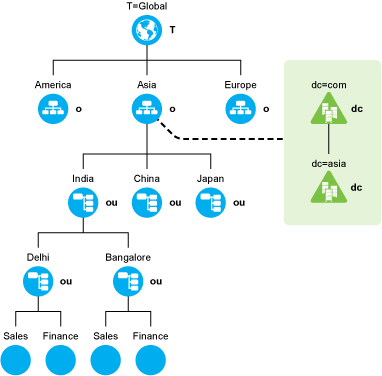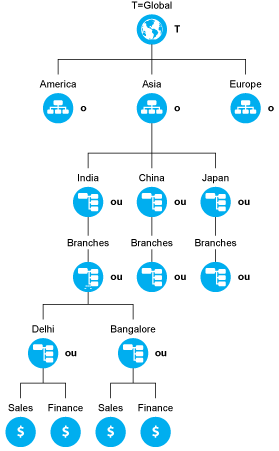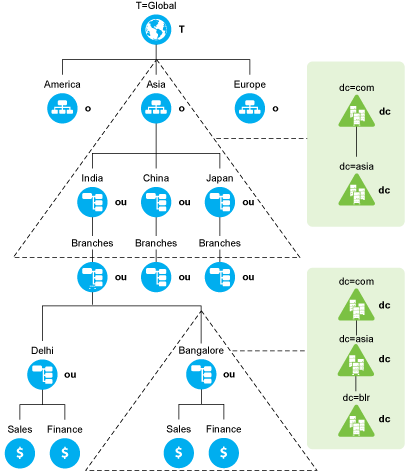4.2 Deploying DSfW in a Name-Mapped Setup
A name-mapped setup refers to a setup where a new DSfW forest is created on an existing eDirectory tree using either a part or the entire eDirectory tree. This enables you to utilize all the user information and other associations in the eDirectory tree. The creation of a DSfW forest into an existing eDirectory tree starts from a specific container. Association of the DSfW forest to a specific container is called mapping and the container is called a mapped container. Different DSfW domains in the DSfW forest are mapped to different DSfW containers. As a prerequisite, the mapped containers must be partitioned.
Though an already existing eDirectory tree can be used for a name-mapped setup, an OES server already configured as an eDirectory server cannot be used to create a domain controller for a DSfW domain. A new server should be added to configure a DSfW domain controller. Before you start the process of installation, refer Installation Prerequisites for a Name-Mapped Setup.
Figure 4-5 represents an example of a name-mapped setup where an existing eDirectory tree T=Global has organization type containers America, Asia, and Europe. Consider a scenario where the container Asia needs to be mapped to a DSfW domain asia.com. As a prerequisite, you must first partition the Asia container and then introduce a new OES server in your eDirectory tree and install DSfW pattern. With successful installation and provisioning of DSfW, the container O=Asia becomes root partition of the DSfW domain. This allows you to utilize all the preexisting users and associations under the subtree starting from the container Asia.
Figure 4-5 Deploying DSfW in an Existing eDirectory Tree

It is also possible to map the partitions underneath O=Asia to a new child domain and skip any levels of containers underneath. Refer section Section 4.2.1, Deploying DSfW by Skipping Containers. So, you can map the OU=India partitioned container to create a new child DSfW domain or directly map OU=Delhi or OU=Sales partitioned container.
Restrictions
Consider the following restrictions while configuring a name-mapped setup:
-
If you have already mapped a partition to a DSfW domain, then you cannot map the sibling partitions to create a new DSfW domain. Using the example in Figure 4-5, if you have already mapped the O=Asia partition, you cannot map the O=America or O=Europe partitions. However, this restriction is applicable only for the first domain or FRD in a forest. For example, in Figure 4-5, the sibling containers under Asia (ou=India,ou=China, and ou=Japan) can be configured as different child domains in the same instance.
-
Installing DSfW in a tree root partition is not supported.
-
While designing a DSfW tree, you must ensure that the length of the DN does not exceed 255 characters. During provisioning, DSfW creates some objects and length of the DN of these DSfW-specific objects is included while calculating the length of the DSfW domain's mapped container. The size of longest default object in a DSfW tree is 144. While calculating the length of the mapped container, the length of the hostname is also taken into consideration. For example, if the hostname is myserver, then the mapped container's DN cannot exceed 255-144-8 (length of the hostname myserver)=103 characters. For more information on provisioning, see Section 7.0, Provisioning Domain Services for Windows.
WARNING:If you deploy the forest root domain too deep down in the tree, further child domain installation may be difficult because the DN mapping range will exhaust.
4.2.1 Deploying DSfW by Skipping Containers
For OES releases prior to OES2 SP3, to map any container in a tree, it was essential to map the parent container and skipping a container at any level was disallowed. However, beginning OES2 SP3, after successful mapping of a container to a DSfW domain, you can map any underlying container to a new DSfW child domain and skip any level of containers in between. For instance, the second level container from a mapped container can be mapped to the immediate DSfW child domain, thus skipping the first level container.
Consider a scenario with an eDirectory tree, as represented in the following figure.
Figure 4-6 Existing eDirectory Tree

As illustrated in Figure 4-7, a domain named asia.com is created which is mapped to the partition o=asia. Now, you can map the partition ou=bangalore to a child domain named blr.asia.com, by excluding the partitions between the domains asia.com and blr.asia.com. The child domain excludes the partition ou=branches. This provides you with an advantage of avoiding an unnecessary server addition and its management in order to maintain the hierarchy.
Figure 4-7 Deploying DSfW by Skipping Containers

4.2.2 Custom Domain Name
DSfW enables you to choose a domain name that need not match the mapped container's typeless RDN. As illustrated in Figure 4-7, you can map the partition ou=bangalore to a DSfW child domain named blr.asia.com. Here the domain component blr is used to map a container with typeless RDN as bangalore.